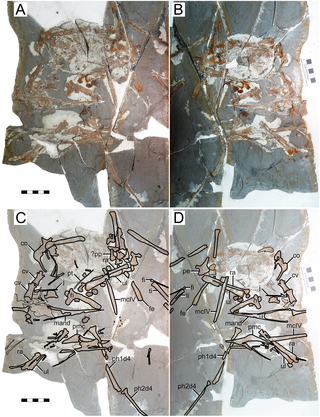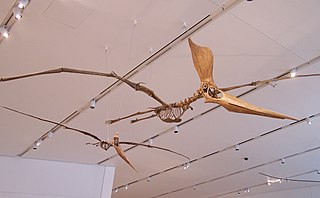
Dimorphodon was a genus of medium-sized pterosaur from the early Jurassic Period. It was named by paleontologist Richard Owen in 1859. Dimorphodon means "two-form tooth", derived from the Greek δι meaning "two", μορφη meaning "shape" and οδων meaning "tooth", referring to the fact that it had two distinct types of teeth in its jaws – which is comparatively rare among reptiles. Dimorphodon inhabited Europe.

Anurognathidae is a family of small, short-tailed pterosaurs that lived in Europe, Asia, and possibly North America during the Jurassic and Cretaceous periods. Five genera are known: Anurognathus, from the Late Jurassic of Germany; Jeholopterus, from the Middle to Late Jurassic of China; Dendrorhynchoides, from the Middle Jurassic of China; Batrachognathus, from the Late Jurassic of Kazakhstan; and Vesperopterylus, from the Early Cretaceous of China. Bennett (2007) suggested that the holotype of Mesadactylus, BYU 2024, a synsacrum, belonged to an anurognathid, though this affinity has been questioned by other authors. Mesadactylus is from the Late Jurassic Morrison Formation of the United States. Indeterminate anurognathid remains have also been reported from the Middle Jurassic Bakhar Svita of Mongolia and the Early Cretaceous of North Korea.

Peteinosaurus was a prehistoric genus of pterosaur. It lived in the late Triassic period in the late Norian age, and at a wingspan of around 60 cm (24 in), was one of the smallest and earliest pterosaurs, although other estimates suggest a wingspan of up to 1 m (3.3 ft).
Boreopterus is a genus of boreopterid pterodactyloid pterosaur from the Barremian-Aptian-age Lower Cretaceous Yixian Formation of Dalian, Liaoning, China.

Eopteranodon is a genus of tapejarid pterosaur from the Aptian-age Lower Cretaceous Yixian Formation of Beipiao City, Liaoning, China. The genus was named in 2005 by paleontologists Lü Junchang and Zhang Xingliao. The type species is Eopteranodon lii.
Rhamphinion is a genus of pterosaurs from the Sinemurian-mid Pliensbachian-age Lower Jurassic Kayenta Formation of northeastern Arizona, United States. The type species is R. jenkinsi.

Ornithocheiroidea is a group of pterosaurs within the extinct suborder Pterodactyloidea. They were typically large pterosaurs that lived from the Early to Late Cretaceous periods, with fossil remains found all over the world except Antarctica.

Glacialisaurus is a genus of sauropodomorph dinosaur. It lived during the Pliensbachian stage of the Early Jurassic period around 186 to 182 million years ago in what is now the central region of the Transantarctic Mountains of Antarctica. It is known from two specimens; the holotype, a partial tarsus (ankle) and metatarsus, and a partial left femur. The fossils were collected by a team led by paleontologist William R. Hammer during a 1990–91 field expedition to the Hanson Formation of Antarctica. They were described in 2007, and made the basis of the new genus and species Glacialisaurus hammeri. The genus name translates as “icy” or "frozen lizard”, and the species name honors Hammer.

Ornithocheiridae is a group of pterosaurs within the suborder Pterodactyloidea. These pterosaurs were among the last to possess teeth. Members that belong to this group lived from the Early to Late Cretaceous periods, around 140 to 90 million years ago.

Carniadactylus is a genus of pterosaur which existed in Europe during the Late Triassic period. The genus contains a single species, Carniadactylus rosenfeldi.

The Caelidracones is a group of pterosaurs.

Dsungaripteridae is a group of pterosaurs within the suborder Pterodactyloidea. They were robust pterosaurs with good terrestrial abilities and flight honed for inland settings.

Novialoidea is an extinct clade of macronychopteran pterosaurs that lived from the latest Early Jurassic to the latest Late Cretaceous, their fossils having been found on all continents except Antarctica.

Eopterosauria is a group of basal pterosaurs from the Triassic, which form their own clade. The term was first used in Andres et al. (2014) to include Preondactylus, Austriadactylus, Peteinosaurus and Eudimorphodontidae. Inside the group were two other new clades, Preondactylia, which included Preondactylus and Austriadactylus, and Eudimorphodontoidea, to include Eudimorphodontidae and Raeticodactylidae. Eopterosauria was defined as "the least inclusive clade containing Preondactylus buffarinii and Eudimorphodon ranzii". The specimen BSP 1994, previously assigned to Eudimorphodon, was named the separate taxon Austriadraco in 2015, and assigned to the new family Austriadraconidae, but further classification was not described. The following phylogenetic analysis follows the topology of Andres et al. (2014).

Pteranodontoidea is an extinct clade of ornithocheiroid pterosaurs from the Early to Late Cretaceous of Asia, Africa, Europe, North America and South America. It was named by Alexander Wilhelm Armin Kellner in 1996. In 2003, Kellner defined the clade as a node-based taxon consisting of the last common ancestor of Anhanguera, Pteranodon and all its descendants. The clade Ornithocheiroidea is sometimes considered to be the senior synonym of Pteranodontoidea, however it depends on its definition. Brian Andres in his analyses, converts Ornithocheiroidea using the definition of Kellner (2003) to avoid this synonymy.

Eudimorphodontidae is an extinct family of early pterosaurs from the Late Triassic of Europe. It was named by Peter Wellnhofer in 1978 to include Eudimorphodon ranzii. Some phylogenetic analyses suggested that Eudimorphodontidae is a junior synonym of Campylognathoididae, however more comprehensive analyses found Eudimorphodontidae to be basal to Macronychoptera that includes Campylognathoididae and more derived pterosaurs (Breviquartossa). Wang et al. (2009) found Eudimorphodontidae to include six species, but they didn't defined the clade. Brian Andres define Eudimorphodontidae and found Peteinosaurus to be most closely related to it. Furthermore, he found monophyletic Eudimorphodon clade, and defined two subfamilies within Eudimorphodontidae. The Eudimorphodontinae includes all taxa more closely related to Eudimorphodon ranzii than to Raeticodactylus filisurensis while the Raeticodactylinae includes all taxa more closely related to Raeticodactylus filisurensis than to Eudimorphodon ranzii. More recently, Raeticodactylus and Caviramus were moved into their own family, Raeticodactylidae. The below cladogram follows that analysis.

Cimoliopterus is a genus of pterosaur that lived during the Late Cretaceous in what is now England and the United States. The first known specimen, consisting of the front part of a snout including part of a crest, was discovered in the Grey Chalk Subgroup of Kent, England, and described as the new species Pterodactylus cuvieri in 1851. The specific name cuvieri honours the palaeontologist George Cuvier, whereas the genus Pterodactylus was then used for many pterosaur species that are not thought to be closely related today. It was one of the first pterosaurs to be depicted as models in Crystal Palace Park in the 1850s. The species was subsequently assigned to various other genera, including Ornithocheirus and Anhanguera. In 2013, the species was moved to a new genus, as Cimoliopterus cuvieri; the generic name Cimoliopterus is derived from the Greek words for "chalk" and "wing". Other specimens and species have also been assigned to or synonymised with the species with various levels of certainty. In 2015, a snout discovered in the Britton Formation of Texas, US, was named as a new species in the genus, C. dunni; the specific name honours its collector, Brent Dunn.

The Nugget Sandstone is a Late Triassic to Early Jurassic geologic formation that outcrops in Colorado, Idaho, Wyoming, and Utah, western United States.

Ornithocheiromorpha is a group of pterosaurs within the suborder Pterodactyloidea. Fossil remains of this group date back from the Early to Late Cretaceous periods, around 140 to 92.5 million years ago. Ornithocheiromorphs were discovered worldwide except Antarctica, though most genera were recovered in Europe, Asia and South America. They were the most diverse and successful pterosaurs during the Early Cretaceous, but throughout the Late Cretaceous they were replaced by better adapted and more advanced pterosaur species such the pteranodontids and azhdarchoids. The Ornithocheiromorpha was defined in 2014 by Andres and colleagues, and they made Ornithocheiromorpha the most inclusive clade containing Ornithocheirus, but not Pteranodon.

Caelestiventus is a pterosaur genus from the Late Triassic found in western North America. The type species, Caelestiventus hanseni, honors Robin Hansen, the Bureau of Land Management geologist (BLM), who facilitated access to the excavation site.






























